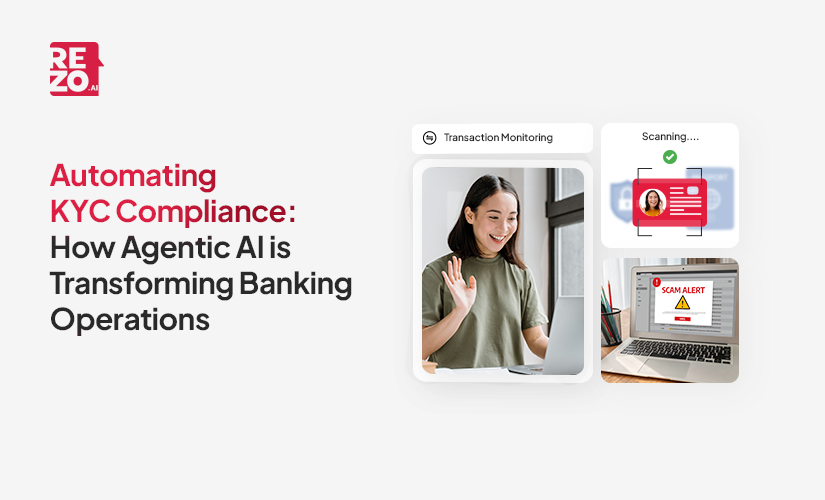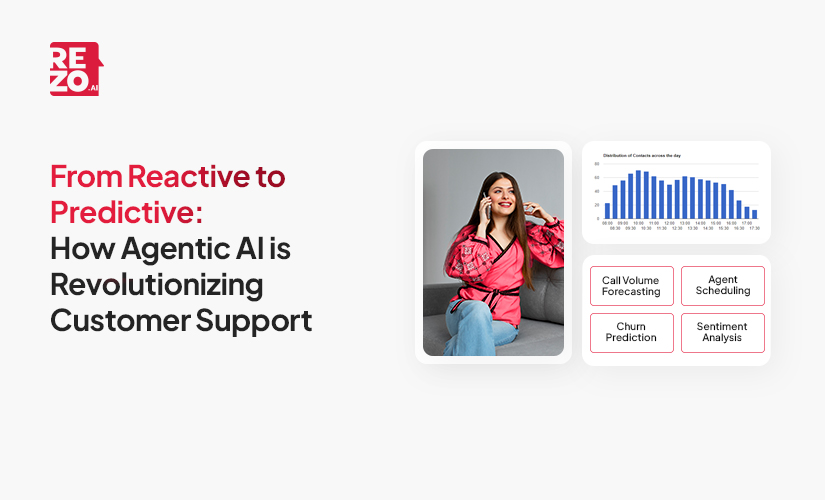
How Agentic AI Improves Cost Efficiency for CX Leaders in 2025?
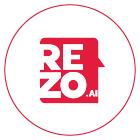
How Agentic AI Improves Cost Efficiency for CX Leaders in 2025?


With the rapid pace of industrial growth, customer needs and expectations have risen proportionately. Today’s customers demand seamless experiences, instant responses, and faster resolutions. As a result, organizations are investing more than ever in enhancing customer experience. According to a report by Adobe Business, 61% of organizations believe that delivering personalized experiences is critical to business growth, while 87% of companies leveraging artificial intelligence (AI) in customer experience have reported significant improvements in customer engagement.
However, the rapid rise in customer demands is not easily scalable for most industries. Expanding contact centers with human agents significantly increases the total cost of ownership (TCO), which is often unsustainable. On the other hand, legacy AI chatbots are limited to handling basic queries with scripted responses, frequently resulting in poor customer satisfaction and higher churn rates.
This is where Agentic AI systems play a transformative role in customer experience. These advanced AI models operate autonomously and are capable of delivering hyper-personalized responses to customer queries. By integrating Agentic AI into customer experience strategies, CX leaders can achieve substantial improvements in both customer satisfaction and cost efficiency.
Understanding Agentic AI
Agentic AI represents a new class of artificial intelligence designed to operate with its own agency. Unlike traditional AI, Agentic AI functions without human assistance , enabling it to resolve issues independently and handle complex tasks with autonomy.
These intelligent agents are powered by advanced algorithms, and large language models, which allow them to work independently, process feedback, and adapt their responses accordingly. As a result, Agentic AI significantly enhances efficiency in contact centers, managing complex business processes seamlessly and reducing the need for constant human oversight.
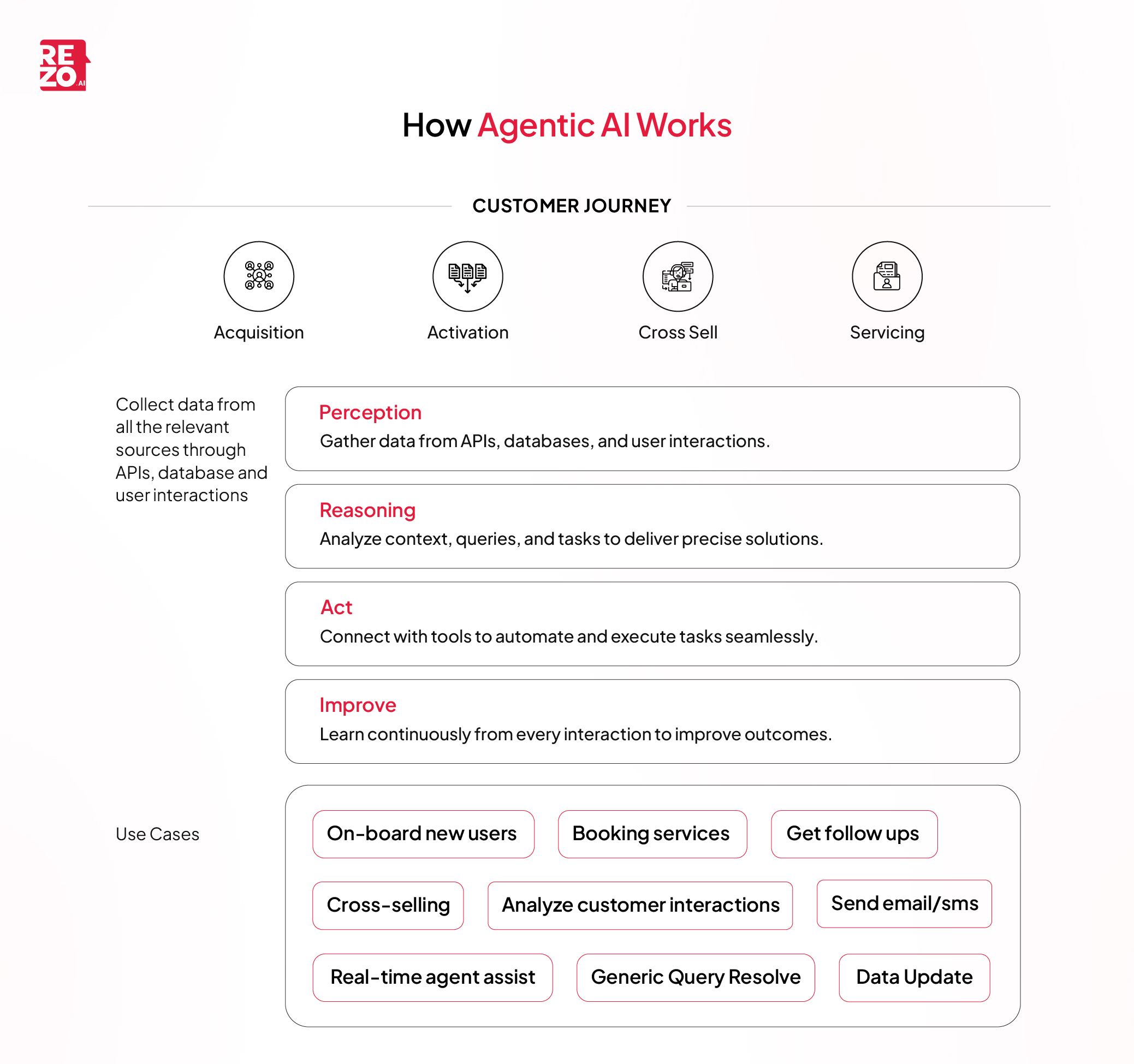
Key Characteristics of Agentic AI
- Autonomous Working:- Agentic AI systems operate with minimal to no human intervention. These intelligent agents can make complex decisions based on customer queries, execute actions independently, and leverage feedback loops to continuously improve their accuracy.
- Proactive, not Reactive:- Unlike legacy AI agents that wait for user input before responding, Agentic AI models adopt a proactive approach. They can analyze customer data, anticipate potential issues, and offer solutions even before the customer raises a concern.
- Goal-Oriented:- Agentic AI systems are designed to work towards specific business goals. They have the ability to formulate and implement strategies to achieve assigned objectives and milestones, ensuring alignment with organizational outcomes.
- Continuous Learning:- A key differentiator between Agentic AI and legacy AI is the ability to learn continuously. By monitoring customer interactions, queries, and feedback, these AI agents refine their performance over time and enhance the overall user experience.
How Agentic AI differs from Traditional AI?
CX Cost Challenges Business Face in 2025
Some of the key contributing factors to cost challenges that companies face include the following:-
- Human Agents:- As organizations scale, the volume of customer interactions increases significantly. While customers expect personalized and timely responses, human agents often struggle to manage rising workloads, leading to burnout and declining efficiency. To address this growing demand, companies are left with two costly options: expanding their in-house agent workforce through hiring and training, or outsourcing customer experience to external contact centers. Both approaches inevitably drive up overall operational costs and reduce long-term scalability.
- Operational Costs:- Organizations must maintain robust infrastructure to support customer engagement, including CRM platforms, legacy AI, subscription and licensing fees, system management, and ongoing maintenance. Additionally, communication tools for agents such as phones and chat platforms, adds to operational expenditures.
- High Employee Turnover:- A significant challenge in customer experience management is the high rate of employee turnover. Large segments of the agent workforce may depart within short timeframes, necessitating constant recruitment and training efforts. This transition not only increases costs but also disrupts service quality, potentially affecting the overall customer experience.
- Hidden Costs:- Customer experience is often accompanied by hidden costs, such as increased customer churn rates stemming from unsatisfactory service. Replacing lost customers is considerably more expensive than retaining existing ones. Poor customer service can further damage brand reputation, reducing future sales and eroding customer loyalty.
Existing AI solutions to CX Cost Challenges
Enterprises have increasingly integrated AI agents to reduce overall call center costs. Over the past decade, artificial intelligence systems powered by generative AI and conversational AI have transformed customer experience operations. Today, a range of AI agents including chatbots, voice bots and other virtual assistants is deployed across various customer engagement functions.
These bots are conversational and rule based. They can respond to basic customer queries and perform repetitive tasks at scale. By automating routine interactions, these agents can support and supplement the work of multiple agents, enhancing efficiency and optimizing resources.
Limitations of Legacy AI used in Customer Experience
However basic generative AI bots fall short in addressing the full spectrum of customer experience challenges. Their limitations often result in dissatisfied customers and lower CSAT scores.
One key gap is their lack of reasoning capabilities. Generative AI bots, while more advanced, are still unable to operate independently. When faced with complex or out-of-scope queries, they frequently fail, leading to customer's dissatisfaction.
Language support is another constraint. Many bots are built to handle only a few languages, leaving businesses unable to serve diverse, multilingual customer bases effectively. This creates friction and prevents the personalized care customers expect.
Finally, most legacy bots are reactive by design. They can handle basic inbound queries but lack the ability to take initiative, anticipate customer needs, or contribute strategically to enhancing customer engagement.
How Agentic AI drives cost savings for CX Eny?
Agentic AI addresses the limitations of generative AI agents by introducing autonomous agents that can operate with minimal human intervention. Leveraging advanced AI technologies such as large language models (LLMs) and natural language processing (NLP), these agents not only drive greater operational efficiency but also enable more intelligent, scalable, and proactive customer interactions.
Autonomous Decision Making
Agentic AI systems have the ability to act independently and resolve multi-step complex queries without human intervention, delivering a seamless and efficient customer experience. For instance, if a customer inquires about the latest car model, the AI agent can not only provide detailed information but also guide the customer further by offering a test-drive booking, presenting available slots and locations, confirming appointments and highlighting any relevant discounts or exchange offers.
In doing so, the AI agent is not just responding, it is actively driving the customer journey by making recommendations, cross-selling and converting inquiries into qualified leads. Better still, this can be done at scale for thousands of customers simultaneously.
In contrast, without Agentic AI, the same process would typically require multiple specialized agents and manual effort. A conversational AI bot might capture basic customer data but human agents would still need to handle the booking, verify nearby dealerships, check discounts and follow up. Processes that are time-consuming and prone to customer drop-off due to delays. Agentic AI eliminates these inefficiencies, creating a faster, more engaging customer experience and significant cost reduction.
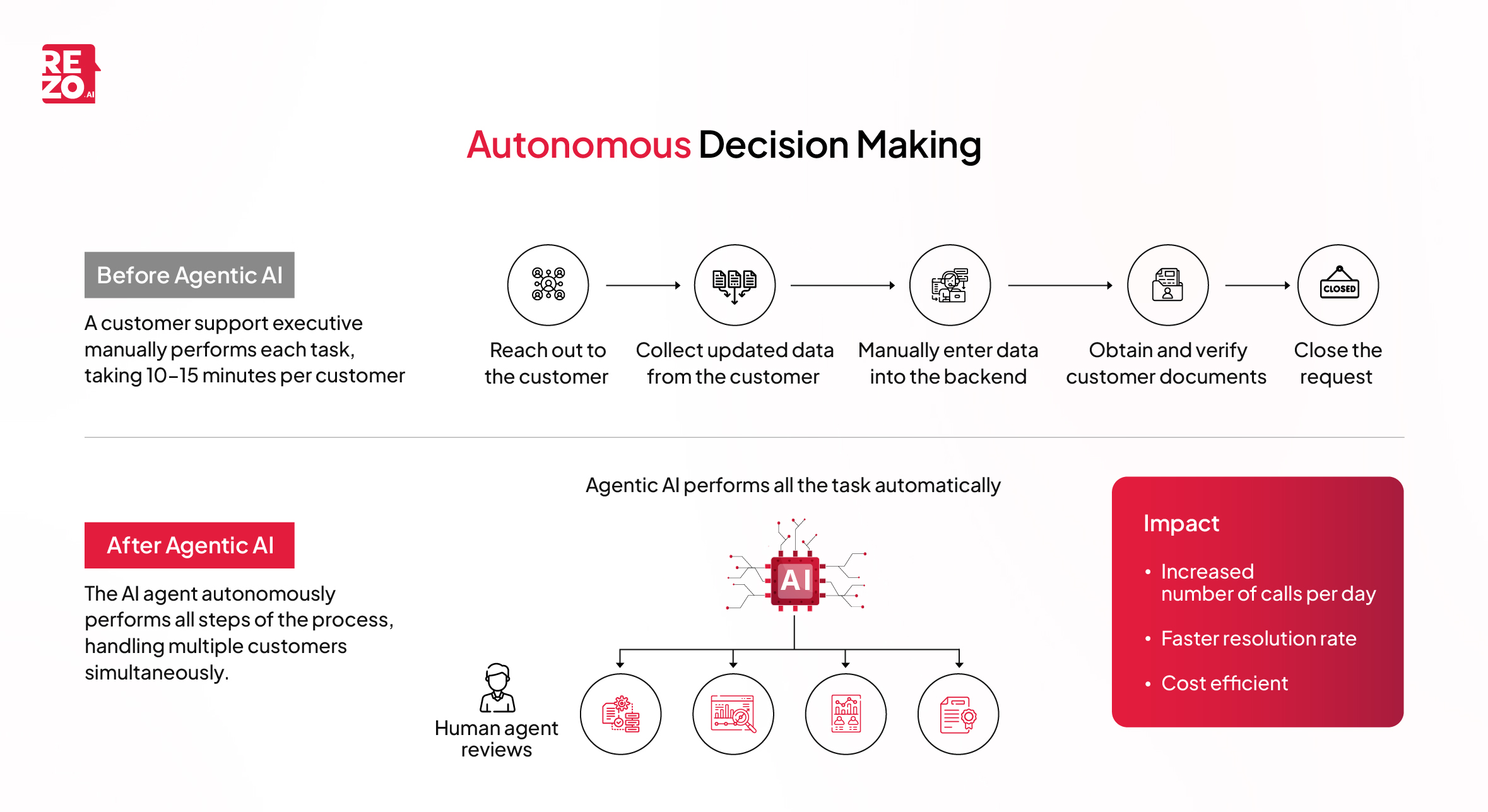
Personalized Interactions with Customers
Agentic AI agents are not bound by rigid rules or scripts. Instead, they process customer queries and responses in real time, improvising to deliver tailored, context-aware interactions. By leveraging adaptive learning, advanced machine learning algorithms and behavioral analytics, these systems can truly understand each customer’s needs and provide highly personalized engagement.
For example, if a customer has recently purchased an air conditioner, the Agentic AI system can proactively reach out even before delivery, offering installation services, extended warranties and suggesting complementary products such as air purifiers or smart thermostats.
At scale, Agentic AI can simultaneously track and manage thousands of customer journeys, providing relevant recommendations and driving cross-sell opportunities. Achieving this level of personalization with existing enterprise system would require extensive manpower running around the clock, significantly inflating the total cost of ownership (TCO) for enterprises while limiting overall revenue potential. Agentic AI allows businesses to overcome these challenges with efficiency, scalability and precision.
Omnichannel Orchestration of Customer Journey
Perhaps one of the biggest Agentic AI feature that leads to contact center cost reduction is its Omnichannel Orchestration. With Agentic AI customers get a uniform experience irrespective of which channel they choose to engage with. Agentic AI systems create a centralised data base where data from different channels are aggregated, to build a customer persona. This in turn leads to a unified customer experience, where no matter the channel, the customer receives personalized and uniform responses.
For example if a customer has raised complains over a faulty product on chat and then moved on to send an email and wants assistance via phone call, the Agentic AI agent will make sure they get a unified experience throughout. This greatly reduces costs and increases customer satisfaction.
Without Agentic AI, data from various channels becomes de-centralized causing a siloed experience where the customer has to repeat their details and concerns over and over across various channels. Additionally for multiple channels, contact centers need more workforce to manage these channels increasing the total cost.

Quality Assurance Automation
Agentic AI systems also complement human agents and make their work easier by streamlining quality assurance (QA) processes. Traditionally, companies must continuously monitor calls to ensure agents deliver accurate resolutions, adhere to standard operating procedures and respond effectively to the voice of the customer (VoC). Manual QA is labor-intensive, costly and often impractical at scale, especially as customer interactions increase and QA teams must grow to keep pace.
By harnessing technologies such as speech analytics, natural language processing and automatic speech recognition, Agentic AI can analyze and transcribe customer calls in real time. These systems can generate detailed agent performance scores based on key metrics, identify agents who need training programs and highlight urgent VoC issues, such as dissatisfied customers or negative feedback.
Agentic AI enables superior, scalable QA by simultaneously evaluating thousands of customer interactions, providing actionable insights for each. This reduces the overhead required for manual monitoring and allows contact centers to enhance quality while significantly lowering operational costs.
Data Management and Handling
Agentic AI offers substantial support to human customer service agents by transforming data management and handling. Enterprises deal with ever-growing volumes of customer data, ranging from new customer profiles and purchase histories to service updates and scheduling. As the customer base expands, it becomes challenging for human agents to manage and track all customer profiles effectively, leading to increased operational costs and missed opportunities to engage dormant customers.
Agentic AI centralizes unstructured data, consolidating customer details from multiple data sources into a unified database that creates comprehensive individual personas. With advanced data segregation, the AI system can target and re-engage dormant customers through personalized outreach or equip human agents with detailed user personas for targeted marketing efforts.
Additionally, Agentic AI empowers agents in real time by providing instant access to critical customer data during interactions. For example, if a customer inquires whether their insurance plan covers a specific medical procedure, the AI can instantly analyze the policy and supply the agent with an accurate answer eliminating the need for time-consuming manual database checks substantially increasing employee productivity. This results in faster call resolutions, enables agents to focus on value-driven tasks and ultimately contributes to higher customer satisfaction and cost efficiencies.

How Enterprises can adapt Agentic AI?
To deliver a truly unified and rewarding customer experience while driving substantial cost efficiencies, business leaders must seamlessly integrate Agentic AI-powered agents across every customer engagement channel. For forward-thinking enterprises, adopting Agentic AI is not merely about deploying smarter chatbots or voicebots, it is about building an intelligent orchestration layer that redefines customer engagement, ensures consistency across touchpoints, and unlocks transformative savings.
Here is how enterprises can harness Agentic AI to realize its full potential:
Build the Right Infrastructure
Agentic AI demands a robust infrastructure that enables AI agents to process vast datasets, act in real time, and operate seamlessly across multiple channels while consistently delivering a unified customer experience.
- Multi-Channel Interfaces:- Today’s customers no longer rely on a single communication channel. They engage with enterprises across voice, email, chat, social, and other touchpoints. Agentic AI requires a resilient infrastructure to unify these channels, retaining context across interactions and ensuring every engagement feels continuous and personalized.
- Integration Layers:- To maximize impact, Agentic AI agents must integrate smoothly with existing enterprise systems such as CRM platforms, ERP systems, billing applications, knowledge bases, and contact center tools. This calls for strong APIs, intelligent middleware, and orchestration layers that enable seamless connectivity, data exchange, and automate entire process.
- Cloud Environment:- Agentic AI relies on advanced models that demand scalable computing power and high-performance storage to process data in real time. Enterprises must therefore invest in robust cloud environments capable of supporting instantaneous, hyper-personalized responses at scale, ensuring agility, reliability, and cost efficiency.
Data Foundation and Knowledge Management
Agentic AI agents must be trained not only on a company’s products and offerings but also on customer data and historical interactions. This enables them to build accurate customer personas and deliver hyper-personalized, contextually relevant, and unique responses for every engagement.
- Knowledge Graphs and Content Feeds:- Agentic AI requires access to both structured and unstructured content that reflects the full depth of a company’s knowledge. This includes policies, FAQs, product catalogs, user manuals, limitations, and real-time updates. By leveraging knowledge graphs and dynamic content feeds, AI agents can understand the context behind each customer query and respond with precision and accuracy.
- Datasets:- In addition to content, Agentic AI agents operates on customer data. This includes past interaction histories across call centers, websites, apps, social channels, and emails. Such data provides a holistic view of customer behavior and preferences. To unlock the true value of this approach, enterprises must ensure the data is clean, reliable, and free from bias. Poor or flawed inputs can undermine outcomes, while well-curated datasets enable the delivery of seamless, personalized, and trust-building customer experiences.
Agent Design and Orchestration
Agentic AI agents are not merely enhanced chatbots; they are intelligent automation systems that combine conversational intelligence with robotic process automation to tackle complex challenges. Unlike traditional bots, these agents can think, act, and execute in real time, enabling enterprises to reimagine customer engagement and operational efficiency.
- Define Agent Roles:- Just like human teams, Agentic AI agents should be deployed with clearly defined responsibilities, aligned to specific Key Result Areas (KRAs) and Key Performance Indicators (KPIs). This structured approach ensures measurable value creation, accountability, and alignment with broader business goals.
- Workflow Automation:- Agentic AI has the capability to orchestrate and automate complex end-to-end workflows. By integrating with backend systems, these agents can perform real actions such as processing refunds, activating or suspending services, updating customer records, or generating reports. This enables faster resolution, reduces manual workload, and drives higher productivity across the enterprise.
Human AI Collaboration
Agentic AI agents are not designed to entirely replace the human workforce. Instead, they serve as powerful enablers, augmenting employee performance and fostering a robust framework for collaboration between humans and intelligent systems.
- Complex Query Handling:- While many customer interactions can be automated, a subset of queries, often involving emotional nuance or sensitive matters that requires human expertise. In these scenarios, Agentic AI supports by triaging and handing off complex cases to human agents, while also learning from these interactions to continuously improve its own capability. This ensures that customers receive empathetic, thoughtful service where needed, reinforcing trust and satisfaction.
- Training and Adoption:- Successful integration of Agentic AI hinges on equipping employees with the necessary skills to work alongside intelligent agents. Structured training programs empower staff to leverage Agentic AI for heightened productivity, superior customer outcomes, and measurable cost savings. This collaborative approach drives both operational excellence and workforce engagement across the enterprise.
Continuous Monitoring and Optimization
Agentic AI systems are dynamic and require ongoing oversight to remain relevant and effective within enterprise environments.
- Performance Dashboards:- Enterprises should deploy comprehensive performance dashboards that track key metrics, including Customer Satisfaction (CSAT), Net Promoter Score (NPS), Average Handling Time (AHT), cost savings, and other outcome-driven KPIs specific to Agentic AI. Monitoring dashboards should be designed for real-time visibility, consolidating core metrics that reflect customer experience improvements and operational efficiency.
- A/B Testing:- Agentic AI enables advanced A/B testing, allowing organizations to run multi-variant experiments on conversation flows, prompts, and workflows. Modern AI agents can automatically design, manage, and adapt tests in real time, segment users, and optimize response strategies based on live feedback. This iterative testing approach ensures continuous improvement and drives greater effectiveness in customer engagement and business outcomes.
Thus, many organizations today are leveraging AI capabilities to orchestrate complex workflows and deliver substantial reductions in call center costs. This strategic adoption not only streamlines operations and drives greater efficiency, but also empowers customer experience and business leaders to focus on delivering higher-value, differentiated customer engagements.
Conclusion
Thus, to conclude, cost savings today is no longer just about cutting corners, but about embracing smarter, more effective ways of working. Agentic AI agents exemplify this shift by automating complex workflows and reducing reliance on human effort for repetitive processes, leading to faster and more precise solutions. By orchestrating end-to-end workflows, these AI agents not only provide significant operational cost reductions, but also empower human teams to concentrate on strategic initiatives and high-value customer interactions. For enterprises looking to achieve more with less, Agentic AI offers both the efficiency gains needed to lower total costs and the strategic advantage needed to invest in long-term customer loyalty.
Frequently Asked Questions
What is Agentic AI and how does it differ from Generative AI in customer experiences?
Agentic AI agents possess autonomy: they can plan, reason, and execute complex, multi-step tasks to achieve specific goals in customer experience and operations. In contrast, Generative AI is primarily reactive, responding to commands or queries
How business are implementing Agentic AI in customer experience?
Businesses can leverage Agentic AI to automate customer experience. Rezo AI’s unified CX Agentic AI platform is one such solution that enterprises can utilize. With its AI engagement, CX analytics and insights, and real-time agent assist features, Rezo AI helps implement Agentic AI in customer experience.
Is Agentic Ai the future of Artificial intelligence?
Yes, Agentic AI can be described as the future of artificial intelligence, as it moves beyond simply following commands and prompts to proactively initiating and executing tasks with its own agency.
Frequently Asked Questions (FAQs)

Take the leap towards innovation with Rezo.ai
Get started now







